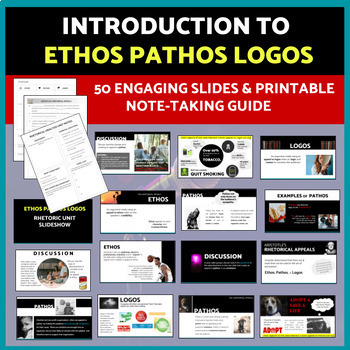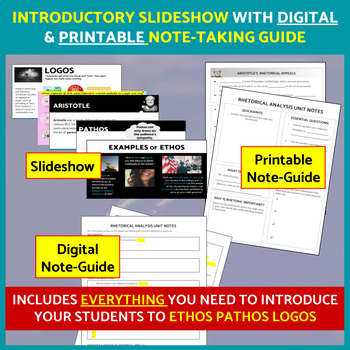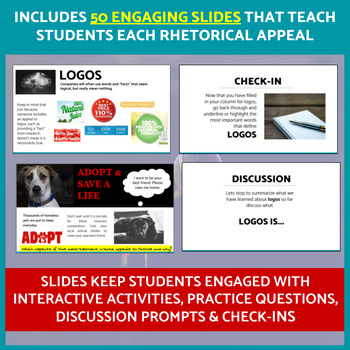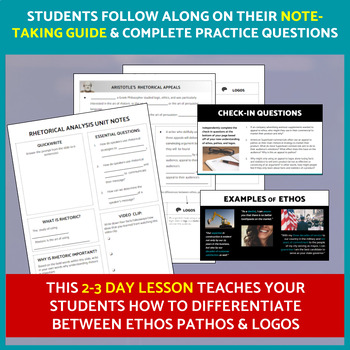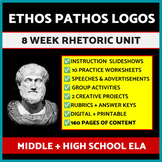Ethos Pathos Logos Notes Worksheet, Unit Slideshow Introduction Powerpoint
- Google Drive™ folder

Also included in
- SAVE 25% OFF with this 8-week Ethos Pathos Logos Mega Bundle. Strengthen your middle and high school student’s rhetorical analysis, argumentation, communication, and persuasive writing skills with a variety of fun and engaging activities that teach argumentative writing. This bundle differs from otPrice $105.28Original Price $141.00Save $35.72
Description
This is a fun introductory ethos pathos logos slideshow and note-taking guide/ worksheet to introduce ethos pathos logos to your middle or high school students. This is my go-to slideshow that I use with my tenth graders when I introduce ethos pathos logos on the first day of our rhetoric unit. The included editable 51 Google Slides review Aristotle's three rhetorical appeals in depth so that students gain a strong understanding of ethos pathos logos and begin building a solid foundation for each rhetorical appeal. The included ethos pathos logos worksheet/ note-taking guide is for students to fill out as they review each slide in the slideshow. The slideshow is highly visual and engages students so that they have fun and collaborate with their peers as they learn ethos pathos and logos. This slideshow and note-taking guide is ideal for teachers who are introducing ethos pathos logos to their students for the first time and are looking for activities that will keep their students highly engaged throughout the week.
SLIDESHOW & NOTE-TAKING GUIDE/WORKSHEET
The slides should be taught over 3 class periods. The slides introduce ethos, pathos, and logos, and then have students practice analyzing each appeal by completing multiple practice activities over the course of the three instructional days. The slides include example advertisements, practice activities, and reflective writing prompts to support students in engaging with each rhetorical appeal in a meaningful way. Students do not just passively listen but instead are engaged throughout each activity because they are asked to complete numerous different exercises with ethos pathos and logos.
Each slide correlates with a section of the student note-taking guide/ worksheet. The purpose of the note-taking guide is to help keep students engaged as well as have students create an ethos pathos logos study guide that they can reference throughout the unit to help them as they eventually use ethos pathos and logos in their own writing. Within the student note-taking guide, students are asked to reflect on their personal experiences in order to help students connect ethos pathos logos to their own lives.
Within the speaker notes sections below each slide, there are teacher notes and tips to help you facilitate each activity so that each ethos pathos logos activity goes seamlessly in your classroom. :) Plus, there is a detailed answer key if needed.
All included activities were created on Google Docs/ Google Slides and are compatible with Google Classroom.
Overall, the slideshow has many engaging advertisement-style examples for students to practice understanding Aristotle's three rhetorical appeals. I have found that students have a lot of fun learning this content. This ethos pathos logos activity slideshow is great for teachers wanting to teach the fundamentals of ethos pathos logos and start the unit off strong. All materials are Common Core aligned. This introductory unit slideshow is part of my larger bundle for my rhetoric unit: Ethos Pathos Logos FULL UNIT PLAN Bundle. This bundle has EVERYTHING you need to teach students how to write using rhetorical appeals and strategies. The bundle includes fun group activities, creative projects, and so much more. Included in the bundle are many of the activities shown below. Make sure to check them out!
- Ethos Pathos Logos Practice Activity & Stations: This is a fun practice activity that gets students moving around the room!
- Ethos, Pathos, Logos Activities & Unit Guide 2: This is the second unit guide which includes 7 more practice activities to continue sharpening up ethos, pathos, logos skills while also incorporating rhetorical strategies into the lesson plans.
- Ethos Pathos Logos Fun Group Commercial Activity: This is one of my favorite lesson activities to do with my students. They get creative and have a lot of fun working together!
- Ethos Pathos Logos: Scavenger Hunt Project Activity: Students chart ethos, pathos, logos in their everyday lives.
- Ethos Pathos Logos Research Project: Digital Brochure: Students create a digital brochure about a topic of their choice where they create an argument and back their claims using Aristotle's 3 appeals.

